Mexican War of Independence
The Mexican War of Independence (Spanish: Guerra de Independencia de México) was an armed conflict, lasting from 1810 to 1821, that resulted in Mexico becoming independent from Spain. Events in Spain itself had a direct impact on the outbreak of the insurgency in 1810 and in the alliance of insurgent leader Vicente Guerrero and royalist-officer-turned insurgent Agustín de Iturbide in 1821, which brought about independence. Napoleon Bonaparte's invasion of Spain in 1808 touched off a crisis of legitimacy of crown rule, since he had placed his brother Joseph on the Spanish throne after forcing the abdication of the Spanish monarch Charles IV. In many of Spain's overseas possessions the local response was to set up juntas ruling in the name of the Bourbon monarchy. In New Spain, however, peninsular-born Spaniards overthrew the rule of Viceroy José de Iturrigaray (1803–08). In 1810, a few American-born Spaniards in favor of independence began plotting an uprising against Spanish rule. It occurred when the parish priest of the village of Dolores, Miguel Hidalgo y Costilla, issued the Cry of Dolores on September 16, 1810. The Hidalgo Revolt touched off the armed insurgency for independence, lasting until 1821. The colonial regime did not expect the size and duration of the insurgency, which spread from the Bajío region north of Mexico City to the Pacific and Gulf Coasts. In 1820 when Spanish liberals overthrew the autocratic rule of Ferdinand VII and arch-conservatives in New Spain saw independence as a way to maintain their position, former royalists and old insurgents formed an alliance under the Plan of Iguala and forged the Army of the Three Guarantees. The momentum of independence saw the collapse of royal government in Mexico and the Treaty of Córdoba ended the conflict.[2]
| Mexican War of Independence | |||||||||
|---|---|---|---|---|---|---|---|---|---|
| Part of the Spanish American wars of independence | |||||||||
 Clockwise from top left: Miguel Hidalgo, José María Morelos, Embrace of Acatempan between Iturbide and Guerrero, Trigarante Army in Mexico City, Mural of independence by O'Gorman | |||||||||
| |||||||||
| Belligerents | |||||||||
|
| |||||||||
| Commanders and leaders | |||||||||
|
Mina (1817) |
| ||||||||
| Casualties and losses | |||||||||
| 250,000–500,000 killed[1] | |||||||||
Part of a series on the |
|---|
| History of Mexico |
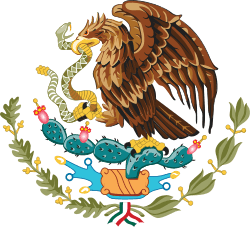 |
|
Spanish rule |
|
| Timeline |
|
|
The movement for independence was inspired by the Age of Enlightenment[3] and the American and French revolutions. By that time the educated elite of New Spain had begun to reflect on the relations between Spain and its colonial kingdoms. Changes in the social and political structure occasioned by Bourbon Reforms and a deep economic crisis in New Spain caused discomfort among the native-born Creole elite.
The dramatic political events in Europe, the French Revolutionary Wars and the conquests by Napoleon deeply influenced events in New Spain. In 1808, Charles IV and Ferdinand VII were forced to abdicate in favor of the French Emperor, who made his elder brother Joseph king of New Spain. The same year, the ayuntamiento (city council) of Mexico City, supported by viceroy José de Iturrigaray, claimed sovereignty in the absence of the legitimate king. That led to a coup against the viceroy; when it was suppressed, the leaders of the movement were jailed.
Despite the defeat in Mexico City, small groups of rebels met in other cities of New Spain to raise movements against colonial rule. In 1810, after being discovered, Querétaro conspirators took up arms on September 16 in the company of peasants and indigenous inhabitants of Dolores (Guanajuato). They were called to action by the secular Catholic priest Miguel Hidalgo, former rector of the Colegio de San Nicolás Obispo.
After 1810 the independence movement went through several stages, as leaders were imprisoned or executed by forces loyal to Spain. At first the rebels disputed the legitimacy of the French-installed Joseph Bonaparte, while recognizing the sovereignty of Ferdinand VII over Spain and its colonies. Later the leaders took more radical positions, rejecting the Spanish claim and espousing a new social order to include the abolition of slavery. Secular priest José María Morelos called the separatist provinces to form the Congress of Chilpancingo, which became the legal framework for the insurgency. After the defeat of Morelos, the movement survived as a guerrilla war under the leadership of Vicente Guerrero. By 1820, few rebel groups survived most notably in the Sierra Madre del Sur and Veracruz.
The reinstatement of the liberal Constitution of Cadiz in 1820 resulted in a change of mind among the elite groups who had supported Spanish rule. Monarchist Creoles affected by the constitution decided to support the independence of New Spain; they sought an alliance with the former insurgent resistance. Agustín de Iturbide led the military arm of the conspirators and in early 1821 he met Vicente Guerrero. Both proclaimed the Plan of Iguala, which called for the union of all insurgent factions. It was supported by both the aristocracy and clergy of New Spain. It called for a monarchy in an independent Mexico. Finally, the independence of Mexico was achieved on September 27, 1821.[4]
After that, the mainland of New Spain was organized as the Mexican Empire.[4] This ephemeral Catholic monarchy was changed to a federal republic in 1823, due both to internal conflicts and the separation of Central America from Mexico. After some Spanish reconquest attempts, including the expedition of Isidro Barradas in 1829, Spain under the rule of Isabella II recognized the independence of Mexico in 1836.[5]
Prior challenges to crown rule

There is evidence that from an early period in post-conquest Mexican history that some elites began articulating the idea of a separate Mexican identity.[6] Despite that, there were relatively few challenges to Spanish imperial power before the insurgency for independence in the early nineteenth century, following the French invasion of the Iberian peninsula in 1808.
One early challenge was by Spanish conquerors whose encomienda grants from the crown, rewards for conquest were to be ended following the deaths of the current grant holders. The encomenderos' conspiracy included Don Martín Cortés (son of Hernán Cortés). The marquis was exiled, other conspirators were executed.[7] Another challenge occurred in 1624 when elites ousted the reformist viceroy who sought to break up rackets from which they profited and curtail opulent displays of clerical power. Viceroy Marqués de Gelves was removed, following an urban riot of Mexico City plebeians in 1624 stirred up by those elites.[8][9] The crowd was reported to have shouted, "Long live the King! Love live Christ! Death to bad government! Death to the heretic Lutheran [Viceroy Gelves]! Arrest the viceroy!" The attack was against Gelves as a bad representative of the crown and not against the monarchy or colonial rule itself.[10] In 1642, there was also a brief conspiracy in the mid-seventeenth century to unite American-born Spaniards, blacks, Indians and castas against the Spanish crown and proclaim Mexican independence. The man seeking to bring about independendence called himself Don Guillén Lampart y Guzmán, an Irishman born William Lamport. Lamport's conspiracy was discovered, and he was arrested by the Inquisition in 1642, and executed fifteen years later for sedition. There is a statue of Lamport in the mausoleum at the base of the Angel of Independence in Mexico City.
At the end of the seventeenth century, there was a major riot in Mexico City, where a plebeian mob attempted to burn down the viceroy's palace and the archbishop's residence. A painting by Cristóbal de Villalpando shows the damage of the 1692 tumulto. Unlike the earlier riot in 1624 in which elites were involved and the viceroy ousted, with no repercussions against the instigators, the 1692 riot was by plebeians alone and racially charged. The rioters attacked key symbols of Spanish power and shouted political slogans. "Kill the [American-born] Spaniards and the Gachupines [Iberian-born Spaniards] who eat our corn! We go to war happily! God wants us to finish off the Spaniards! We do not care if we die without confession! Is this not our land?"[11] The viceroy attempted to address the apparent cause of the riot, a hike in maize prices that affected the urban poor. But the 1692 riot "represented class warfare that put Spanish authority at risk. Punishment was swift and brutal, and no further riots in the capital challenged the Pax Hispanica."[12]
The various indigenous rebellions in the colonial era were often to throw off crown rule, but they were not an independence movement as such. However, during the war of independence, issues at the local level in rural areas constituted what one historian has called "the other rebellion."[13]
American-born Spaniards in New Spain developed a special understanding and ties to their New World homeland, what has been seen the formation of creole patriotism. They did not, however, pursue political independence from Spain until the Napoleonic invasion of the Iberian peninsula and defeat of Spain destabilized the monarchy.[14][15] With the implementation of the mid eighteenth-century Bourbon Reforms, the Spanish crown sought to impose restrictions on American-born Spanish elites, limiting their access to high office in favor of peninsular-born Spanish men.
In the early 19th century, Napoleon's occupation of Spain and ouster of the Spanish monarch led to numerous revolts against royal government across Spanish America. After the abortive 1799 Conspiracy of the Machetes in Mexico, in 1810 a massive revolt in the Bajío region was led by secular cleric Miguel Hidalgo y Costilla.[16] His Grito de Dolores in 1810 was a call to arms answered by many plebeians and marked the first stage of the insurgency for Mexican independence.[16][17] Before 1810, there was no significant support for independence and once the Hidalgo revolt was underway, it received major support only in the Bajío and southern coastal regions.[18]
French invasion of Spain and political crisis in New Spain, 1808-09

The Napoleonic invasion of the Iberian Peninsula destabilized not only Spain but also Spain's overseas possessions. The viceroy was the "king’s living image"[19] in New Spain. In 1808 viceroy José de Iturrigaray (1803-1808) was in office when Napoleon's forces invaded Iberia and deposed the Spanish monarch Charles IV and Napoleon's brother Joseph was declared the monarch. This turn of events set off a crisis of legitimacy. Viceroy Iturrigaray had been appointed by Charles IV, so his legitimacy to rule was not in doubt. In Mexico City, the city council (ayuntamiento), a stronghold of American-born Spaniards, began promoting ideas of autonomy for New Spain, and declaring New Spain to be on an equal basis to Spain. Their proposal would have created a legitimate, representative, and autonomous government in New Spain, but not necessarily breaking from the Spanish Empire. Opposition to that proposal came from conservative elements, including the peninsular-born judges of the High Court (Audiencia), who voiced peninsulars’ interests. Iturrigaray attempted to find a compromise between the two factions, but failed. Upon hearing the news of the Napoleonic invasion some elites suspected that Iturrigaray intended to declare the viceroyalty a sovereign state and perhaps establish himself as head of a new state. With the support of the archbishop, Francisco Javier de Lizana y Beaumont, landowner Gabriel de Yermo, the merchant guild of Mexico City (consulado), and other members of elite society in the capital, Yermo led a coup d'état against the viceroy. They stormed the Viceregal Palace in Mexico City, the night of September 15, 1808, deposing the viceroy, and imprisoning him along with some American-born Spanish members of the city council. The peninsular rebels installed Pedro de Garibay as viceroy. Since he was not a crown appointee, but rather the leader of a rebel faction, creoles viewed him as an illegitimate representative of the crown. The event radicalized both sides. For creoles, it was clear that to gain power they needed to form conspiracies against peninsular rule, and later they took up arms to achieve their goals.[20] Garibay was of advanced years and held office for just a year, replaced by Archbishop Lizana y Beaumont, also holding office for about a year. There was a precedent for the archbishop serving as viceroy, and given that Garibay came to power by coup, the archbishop had more legitimacy as ruler. Francisco Javier Venegas was appointed viceroy and landed in Veracruz in August, reaching Mexico City September 14, 1810. The next day, Hidalgo issued his call to arms in Dolores.
The Hidalgo revolt (1810–1811)
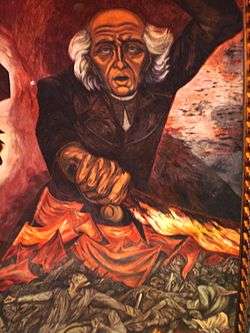
Miguel Hidalgo y Costilla is considered the father of Mexican independence, whose uprising on 16 September 1810 is considered the spark igniting the Mexican War of Independence. He inspired tens of thousands to follow him, but did not organize them into a disciplined fighting force or have a broad military strategy, but he did want to destroy the old order. Fellow insurgent leader and second in command, Ignacio Allende, said of Hidalgo, "Neither were his men amenable to discipline, nor was Hidalgo interested in regulations."[21] Hidalgo issued a few important decrees in the later stage of the insurgency, but did not articulate a coherent set of goals much beyond his initial call to arms denouncing bad government. Only following Hidalgo's death in 1811 under the leadership of his former seminary student, Father José María Morelos, was a document created that made explicit the goals of the insurgency, the Sentimientos de la Nación ("Sentiments of the Nation") (1813). One clear point was political independence from Spain. Despite its having only a vague ideology, Hidalgo's movement demonstrated the massive discontent and power of Mexico's plebeians as an existential threat to the imperial regime. The government focused its resources on defeating Hidalgo's insurgents militarily and in tracking down and publicly executing its leadership. But by then the insurgency had spread beyond its original region and leadership.
Hidalgo was a learned priest who knew multiple languages, had a significant library, and was friends men who held Enlightenment views. He held the important position of rector of the Seminary of San Nicolás, but had run afoul of the Inquisition for unorthodox beliefs and speaking against the monarchy. He had already sired two daughters with Josefa Quintana. Following the death of his brother Joaquín in 1803, Hidalgo, who was having money problems due to debts on landed estates he owned, became curate of the poor parish of Dolores. He became member of a group of well-educated American-born Spaniards in Querétaro. They met under the guise of being a literary society, supported by the wife of crown official (corregidor) Miguel Domínguez, Josefa Ortíz de Domínguez, known now as "La Corregidora." Instead the members discussed the possibility of a popular rising, similar to one that already had recently been quashed in Valladolid (now Morelia) in 1809 in the name of Ferdinand VII.[22][23] Hidalgo was friends with Ignacio Allende, a captain in the regiment of Dragoons in New Spain, who was also among the conspirators. The "Conspiracy of Querétaro" began forming cells in other Spanish cities in the north, including Celaya, Guanajuato, San Miguel el Grande, now named after Allende. Allende had served in a royal regiment during the rule of José de Iturrigaray, who was overthrown in 1808 by peninsular Spaniards who considered him too sympathetic to the grievances of American-born Spaniards. With the ouster of the viceroy, Allende turned against the new regime and was open to the conspiracy for independence. Hidalgo joined the conspiracy, and with Allende vouching for him rose to being one of its leaders. Word of the conspiracy got to crown officials, and the corregidor Domínguez cracked down, but his wife Josefa was able to warn Allende who then alerted Hidalgo. At this point there was no firm ideology or action plan, but the tip-off galvanized Hidalgo to action. On Sunday, September 16, 1810 with his parishioners gathered for mass, Hidalgo issued his call to arms, the Grito de Dolores.[24] It is unclear what Hidalgo actually said, since there are different accounts. The one which became part of the official record of accusation against Hidalgo was "Long live religion! Long live Our Most Holy Mother of Guadalupe! Long live Fernando VII! Long live America and down with bad government!"[25]
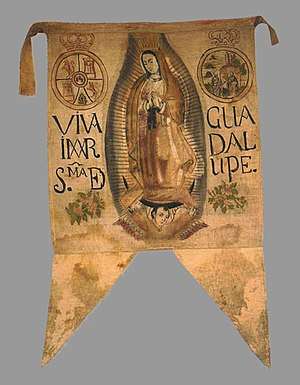
From a small gathering at the Dolores church, other joined the rising including workers on local landed estates, prisoners liberated from jail, and a few members of a royal army regiment. Many estate workers' weapons were agricultural tools now to be used against the regime. Some were mounted and acted as a cavalry under the direction of their estate foremen. Others were poorly armed Indians with bows and arrows.[26] The numbers joining the revolt rapidly swelled under Hidalgo's leadership, they began moving beyond the village of Dolores. Despite rising tensions following the events of 1808, the royal regime was largely unprepared for the suddenness, size, and violence of the movement.

The religious character of the movement was present from the beginning, embodied in leadership of the priest, Hidalgo. The movement's banner with image of the Virgin of Guadalupe, seized by Hidalgo from the church at Atotonilco, was symbolically important. The "dark virgin" was seen as a protector of dark-skinned Mexicans, and now seen as well as a liberator.[27] Many men in Hidalgo's forces put the image of Guadalupe on their hats.[28] Supporters of the imperial regime took as their patron the Virgin of Remedios, so that religious symbolism was used by both insurgents and royalists.[29] There were a number of parish priests and other lower clergy in the insurgency, most prominently Hidalgo and José María Morelos, but the Church hierarchy was flatly opposed. Insurgents were excommunicated by the clergy and clerics preached sermons against the insurgency.[30]
They were not organized in any formal fashion, more of a mass movement than an army. Hidalgo inspired his followers, but did not organize or train them as a fighting force, nor impose order and discipline on them. A few militia men in uniform joined Hidalgo's movement and attempted to create some military order and discipline, but they were few in number. The bulk of the royal army remained loyal to the imperial regime, but Hidalgo's rising had caught them unprepared and their response was delayed. Hidalgo's early victories gave the movement momentum, but "the lack of weapons, trained soldiers, and good officers meant that except in unusual circumstances the rebels could not field armies capable of fighting conventional battles against the royalists."[31]
The growing insurgent force marched through towns including San Miguel el Grande and Celaya, where they met little resistance, and gained more followers. When they reached the town of Guanajuato on September 28, they found Spanish forces barricaded inside the public granary, Alhóndiga de Granaditas. Among them were some 'forced' Royalists, creoles who had served and sided with the Spanish. By this time, the rebels numbered 30,000 and the battle was horrific. They killed more than 500 European and American Spaniards, and marched on toward Mexico City.

The new viceroy quickly organized a defense, sending out the Spanish general Torcuato Trujillo with 1,000 men, 400 horsemen, and 2 cannons - all that could be found on such short notice. The crown had established a standing military in the late eighteenth century, granting non-Spaniards who served the fuero militar, the only special privileges for mixed-race men were eligible. Indians were excluded from the military. Royal army troops of the professional army were supplemented by local militias. The regime was determined to crush the uprising and attempted to stifle malcontents who might be drawn to the insurgency.[32]
Ignacio López Rayón joined Hidalgo's forces whilst passing near Maravatío, Michoacan while en route to Mexico City and on October 30, Hidalgo's army encountered Spanish military resistance at the Battle of Monte de las Cruces. As the Hidalgo and his forces surrounded Mexico City, a group of 2,5000 royalists women joined together under Ana Iraeta de Mier, to create and distribute pamphlets based on their loyalty towards Spain and help fellow loyalist families.[33] Hidalgo's forces continued to fight and achieved victory. When the cannons were captured by the rebels, the surviving Royalists retreated to the City.
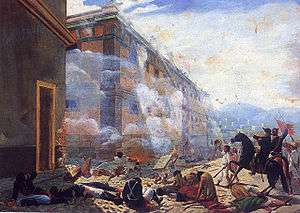
Despite apparently having the advantage, Hidalgo retreated, against the counsel of Allende. This retreat, on the verge of apparent victory, has puzzled historians and biographers ever since. They generally believe that Hidalgo wanted to spare the numerous Mexican citizens in Mexico City from the inevitable sacking and plunder that would have ensued. His retreat is considered Hidalgo's greatest tactical error[34] and his failure to act "was the beginning of his downfall."[35] Hidalgo moved west and set up headquarters in Guadalajara, where one of the worst incidents of violence against Spanish civilians occurred, a month of massacres from December 12, 1810 (the Feast of the Virgin of Guadalupe) to January 13, 1811. At his trial followoing his capture later that year, Hidalgo admitted to ordering the murders. None "were given a trial, nor was there any reason to do so, since he knew perfectly well they were innocent."[36] In Guadalajara, the image of the Virgin of Guadalupe suddenly disappeared from insurgents' hats and there were many desertions.[37]
The royalist forces, led by Félix María Calleja del Rey, were becoming more effective against disorganized and poorly armed of Hidalgo, defeating them at a bridge on the Calderón River, forcing the rebels to flee north towards the United States, perhaps hoping they would attain financial and military support.[38] They were intercepted by Ignacio Elizondo, who pretended to join the fleeing insurgent forces. Hidalgo and his remaining soldiers were captured in the state of Coahuila at the Wells of Baján (Norias de Baján).[39]:26–27 When the insurgents adopted the tactics of guerrilla warfare and operated where it was effective, such as in the hot country of southern Mexico, they were able to undermine the royalist army.[40] Around Guanajuato, regional insurgent leader Albino García for a time successfully combined insurgency with banditry.[41] With the capture of Hidalgo and the creole leadership in the north, this phase of the insurgency was at an end.
The captured rebel leaders were found guilty of treason and sentenced to death, except for Mariano Abasolo, who was sent to Spain to serve a life sentence in prison. Allende, Jiménez, and Aldama were executed on 26 June 1811, shot in the back as a sign of dishonor.[39]:27 Hidalgo, as a priest, had to undergo a civil trial and review by the Inquisition. He was eventually stripped of his priesthood, found guilty, and executed on 30 July 1811. The heads of Hidalgo, Allende, Aldama, and Jiménez were preserved and hung from the four corners of the Alhóndiga de Granaditas of Guanajuato as a grim warning to those who dared follow in their footsteps.[39]:27
Insurgency in the South under Morelos, 1811-1815
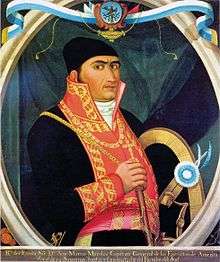
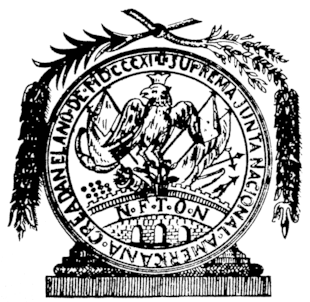
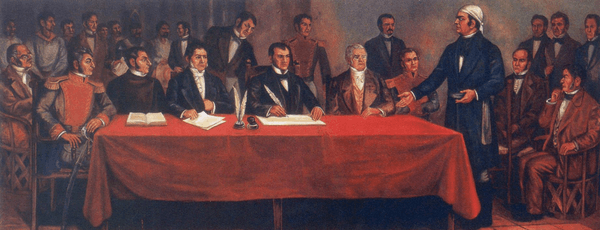
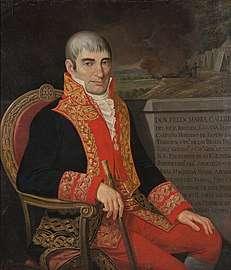
Warfare in the northern Bajío region waned after the capture and execution of the insurgency's creole leadership, but the insurgency had already spread to other more southern regions, to the towns of Zitácuaro, Cuautla, Antequera (now Oaxaca) towns where a new leadership had emerged. Priests José María Morelos and Mariano Matamoros, as well as Vicente Guerrero, Guadalupe Victoria, and Ignacio López Rayón carried on the insurgency on a different basis, organizing their forces, using guerrilla tactics, and importantly for the insurgency, creating organizations and creating written documents that articulated the insurgents' goals.
Following the execution of Hidalgo and other insurgents, leadership of the remaining insurgent movement initially coalesced under Ignacio López Rayón, a civilian lawyer and businessman. He had been stationed in Saltillo, Coahuila with 3,500 men and 22 cannons. When he heard of the capture of the insurgent leaders, he fled south on 26 March 1811 to continue the fight. He subsequently fought the Spanish in the battles of Puerto de Piñones, Zacatecas, El Maguey, and Zitácuaro.
In an important step, Rayón organized the Suprema Junta Gubernativa de América (Supreme National Governing Junta of America), which claimed legitimacy to lead the insurgency. Rayón articulated Elementos constitucionales, which states that "Sovereignty arises directly from the people, resides in the person of Ferdinand VII, and is exercised by the Suprema Junta Gubernativa de América.[42] The Supreme Junta generated a flood of detailed regulations and orders. On the ground, Father José María Morelos pursued successful military engagements, accepting the authority of the Supreme Junta. After winning victories and taking the port of Acapulco, then the towns Tixtla, Izúcar, and Taxco, Morelos was besieged for 72 days by royalist troops under Calleja at Cuautla.[43] The Junta failed to send aid to Morelos. Morelos's troops held out and broke out of the siege, going on to take Antequera, (now Oaxaca). The relationship between Morelos and the Junta soured, with Morelos complaining, "Your disagreements have been of service to the enemy."[44]
Morelos was a real contrast to Hidalgo, although both were rebel priests. Both had sympathy for Mexico's downtrodden, but Morelos was of mixed-race while Hidalgo was an American-born Spaniard, so Morelos experientially understood racial discrimination in the colonial order. On more practical grounds, Morelos built an organized and disciplined military force, while Hidalgo's followers lacked arms, training, or discipline, an effective force that the royal army took seriously. Potentially Morelos could have taken the colony's second largest city, Puebla de los Angeles, situated halfway between the port of Veracruz and the capital, Mexico City. To avert that strategic disaster, which would have left the capital cut off from its main port, viceroy Venegas transferred Calleja from the Bajío to deal with Morelos's forces. Morelos's forces moved south and took Oaxaca, allowing him to control most of the southern region. During this period, the insurgency had reason for optimism and formulated documents declaring independence and articulating a vision for a sovereign Mexico.[45]
Morelos was not ambitious to become leader of the insurgency, but it was clear that he was recognized by insurgents as its supreme military commander. He moved swiftly and decisively, stripping Rayón of power, dissolving the Supreme Junta, and in 1813, Morelos convened the Congress of Chilpancingo, also known as the Congress of Anáhuac. The congress brought together representatives of the insurgency together. Morelos formulated his Sentiments of the Nation, addressed to the congress. In point 1, he clearly and flatly states that "America is free and independent of Spain." On 6 November of that year, the Congress signed the first official document of independence, known as the Solemn Act of the Declaration of Independence of Northern America. In addition to declaring independence from Spain, the Morelos called for the establishment of Catholicism as the only religion (but with certain restrictions), the abolition of slavery and racial distinctions between and of all other nations," going on in point 5 to say, "sovereignty springs directly from the People." His second point makes the "Catholic Religion" the only one permissible, and that "Catholic dogma shall be sustained by the Church hierarchy" (point 4). The importance of Catholicism is further emphasized to mandate December 12, the feast of the Virgin of Guadalupe, as a day to honor her. A provision of key importance to dark-skinned plebeians (point 15) is "That slavery is proscribed forever, , as well as the distinctions of caste [race], so that all shall be equal; and that the only distinction between one American and another shall be that between vice and virtue.". Also important for Morelos's vision of the new nation was equality before the law (point 13), rather than maintaining special courts and privileges (fueros) to particular groups, such as churchmen, miners, merchants, and the military.[46]
The Congress elected Morelos as the head of the executive branch of government, as well as supreme commander of the insurgency, coordinating its far-flung components.[47] The formal statement by the Congress of Chilpancingo, the Solemn Act of the Declaration of Independence, is an important formal document in Mexican history, since it declares Mexico an independent nation and lays out its powers as a sovereign state to make war and peace, to appoint ambassadors, and to have standing with the Papacy, rather than indirectly through the Spanish monarch. The document enshrines Roman Catholicism the sole religion.
Calleja restructured the royal army in an attempt to crush the insurgency, creating commands in Puebla, Valladolid (now Morelia), Guanajuato, and Nueva Galicia, with experienced peninsular military officers to lead them. American-born officer Agustín de Iturbide was part of this royalist leadership. Brigadier Ciriaco de Llano captured and executed Mariano Matamoros, an effective insurgent. After the dissolution of the Congress of Chilpancingo, Morelos was captured 5 November 1815, interrogated, was tried and executed by firing squad. With his death, conventional warfare ended and guerrilla warfare continued uninterrupted.[48]
Insurgency under Vicente Guerrero, 1815-1820
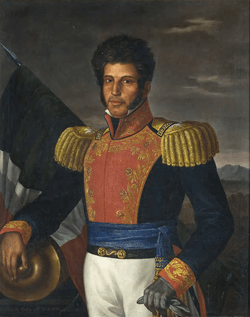
With the execution of Morelos in 1815, Vicente Guerrero emerged as the most important leader of the insurgency. From 1815 to 1821 most of the fighting for independence from Spain was by guerrilla forces in the tierra caliente (hot country) of southern Mexico and to a certain extent in northern New Spain. In 1816, Francisco Javier Mina, a Spanish military leader who had fought against Ferdinand VII, joined the independence movement. Mina and 300 men landed at Rio Santander (Tamaulipas) in April, in 1817 and fought for seven months until his capture by royalist forces in November 1817.[39]:55–58
Two insurgent leaders arose: Guadalupe Victoria (born José Miguel Fernández y Félix) in Puebla and Vicente Guerrero in the village of Tixla, in what is now the state of Guerrero. Both gained allegiance and respect from their followers. Believing the situation under control, the Spanish viceroy issued a general pardon to every rebel who would lay down his arms. Many did lay down their arms and received pardons, but when the opportunity arose, they often returned to the insurgency. The royal army controlled the major cities and towns, but whole swaths of the countryside were not pacified. From 1816-20, the insurgency was stalemated, but not stamped out. Royalist military officer, Antonio López de Santa Anna led amnestied former insurgents, pursuing insurgent leader Guadalupe Victoria. Insurgents attacked key roads, vital for commerce and imperial control, such that the crown sent a commander from Peru, Brigadier Fernando Miyares y Mancebo, to build a fortified road between the port of Veracruz and Jalapa, the first major stopping point on the way to Mexico City.[49] The rebels faced stiff Spanish military resistance and the apathy of many of the most influential criollos.[50]
The period 1816-20 is often considered a period of military stalemate, unable to delivery a knockout blow. Insurgents often settled into guerrilla warfare with some banditry, while royalist forces became increasingly demoralized. Spain sent insufficient reinforcements, although a number of senior officers arrived. By 1814, the Peninsular War against Napoleon was won and Ferdinand VII became the monarch, initially as a constitutional ruler under the Spanish constitution of 1812, but once in power, reneged on promises to have constitutional limits on his power. Crown resources did not go toward funding the war against the insurgents, so that many expeditionary soldiers were not paid and left to their own devices in territory largely controlled by insurgents. Rather than risk life and limb fighting insurgents, they avoided risky operations and stayed close to fortified garrisons. Since money to pay and supply soldiers was not forthcoming from the crown, royal forces pressed local populations for supplies. As for high officers, many saw the hopelessness of the situation and decided to make the best of it by creating what one historian has called "veritable satrapies," becoming wealthy from confiscated insurgent properties, and taxing local merchants.[51]
In what was supposed to be the final government campaign against the insurgents, in December 1820, Viceroy Juan Ruiz de Apodaca sent a force led by a royalist American-born Spaniard Colonel Agustín de Iturbide, to defeat Guerrero's army in Oaxaca. Iturbide, a native of Valladolid (now Morelia), had gained renown for his zeal against Hidalgo's and Morelos's rebels during the early independence struggle. A favorite of the Mexican church hierarchy, Iturbide symbolized conservative creole values; he was devoutly religious and committed to the defense of property rights and social privileges. He also resented his lack of promotion and failure to gain wealth.[52]
Guerrero, Iturbide, and the Plan of Iguala
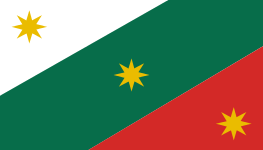
Iturbide's assignment to the Oaxaca expedition in 1820 coincided with a successful military coup in Spain against the monarchy of Ferdinand VII. The coup leaders, part of an expeditionary force assembled to suppress the independence movements in the Americas, had turned against the autocratic monarchy. They compelled the reluctant Ferdinand to reinstate the liberal Spanish Constitution of 1812 that created a constitutional monarchy. When news of the liberal charter reached New Spain, Iturbide perceived it both as a threat to the status quo and a catalyst to rouse the creole elites to gain control of Mexico. Independence was achieved when conservative Royalist forces in the colonies chose to rise up against the liberal regime in Spain; it was an about-face compared to their previous opposition to the peasant insurgency.
The royalist army was demoralized and the insurgents were unable to oust them. With the re-imposition of the Spanish Constitution, the relationship between newly elected town councils (ayuntamientos) and the miliary. Councils could put limits on taxation and many voted to cease exacting taxes to support the royalist army. Commanders lost their financial support and could no longer compel men to join militias. Militias were demobilized and men who had served outside of their native areas went home. The insurgents no longer felt the continuous pressure of the royalist military. Militia men abandoned areas where insurgents were active.[51]
With the situation changed in because of the Spanish Constitution, Guerrero realized that creole elites might move toward independence and exclude the insurgents. For that reason, his reaching an accommodation with the royalist army became a pragmatic move. From the royalist point of view, forging an alliance with their former foes created a way forward to independence. If creoles had declared independence for their own political purposes without coming to terms with the insurgency in the south, then an independent Mexico would have to contend with rebels who could threaten a new nation. Iturbide initiated contact with Guerrero in January 1821, indicating he was weighing whether to abandon the royalist cause. Guerrero was receptive to listening to Iturbide's vague proposal, but was not going to commit without further clarification. Iturbide replied to Guerrero's demand for clarity, saying that he had a plan for a constitution, one apparently based on the 1812 Spanish liberal constitution. Guerrero responded that the failure of that constitution to address the grievances of many in New Spain, and particularly objected to that constitution's exclusion of Afro-Mexicans from citizenship, while according it to European whites, Indians, and mestizos. The question of equality for all races was a key matter for Guerrero and other insurgents, many of whom were had African ancestry. Iturbide accepted that important change. The two men negotiated about how the merging of the old insurgent forces and the former royalist army would occur. Iturbide wrote the final draft of the Plan of Iguala, named for the place where it was proclaimed on 24 February 1821. To reach an accord that both sides would accept, the plan explicitly laid out the terms of equality. For people of mixed race, point 12 made explicit "All inhabitants of New Spain, without distinction to their being Europeans, Africans, or Indians, are citizens of this Monarchy with the option to seek all employment according to their merits and virtues." For European whites, their privileged place in Mexico was to be maintained, guaranteeing their place in existing positions in government. "All branches of the government service will remain without alteration, and that all those presently employed in politics, the church, civilian business, or the military will retain the same positions held at present." Racial designations of Mexicans and distinctions between creole and peninsular Spaniards were abolished [53]
Although the alliance of Iturbide and Guerrero resulted in the Plan of Iguala, there was not universal acclaim of the accord. A number of important insurgents, including Juan Alvarez, Pedro Ascensio, and Gordiano Guzmán rejected it. Guzmán articulated his objection to the plan, saying that it guaranteed the privileges of the elites, welcomed opportunists who supported independence late in the struggle, and cast doubt on the clause that was to guarantee racial equality. He focused on the final words that guaranteed rights "according to their merits and virtues." They declined to join the Army of the Three Guarantees, the military force created by Iturbide and Guerrero, but did continue to fight the royalists.[54]
Collapse of imperial rule and independence
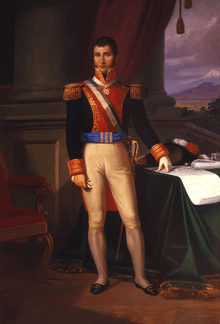
Iturbide had to persuade royalist officers to change sides and support independence as well as the mixed-race old insurgent forces. For some royalist commanders, their forces simply left, some of them amnestied former insurgents. The high military command in Mexico City deposed the viceroy, Juan Ruiz de Apodaca in July, replacing him with interim viceroy, royalist general Francisco Novella. By the time that the new viceroy Juan O'Donojú, practically the whole country supported the Plan of Iguala. Most soldiers had defected to Iturbide's Army of the Three Guarantees and the Spanish cause was lost.[55] On August 24, 1821, representatives of the Spanish crown, including the new viceroy Juan O'Donojú and Iturbide signed the Treaty of Córdoba, which recognized Mexican independence under the Plan of Iguala. O'Donojú then resigned as viceroy. The Spanish government denied that O'Donojú had the authority to sign the treaty, but events on the ground saw Iturbide and the Army of Three Guarantees march into Mexico City in triumph on 27 September 1821. The next day, the Mexican independence was proclaimed in the Declaration of Independence of the Mexican Empire. The Plan of Iguala and the Treaty of Córdoba had rapidly brought about an alliance of insurgents and former royalists turned autonomists resulting in the rapid achievement of independence virtually without further military conflict. Once independence was achieved, the fissures between different interests rapidly re-emerged.[56]
Creation of the First Mexican Empire
On September 27, 1821, the Army of the Three Guarantees entered Mexico City, and the following day Iturbide proclaimed the independence of the Mexican Empire, as New Spain was henceforth to be called. The Treaty of Córdoba was not ratified by the Spanish Cortes. Iturbide included a special clause in the treaty that left open the possibility for a criollo monarch to be appointed by a Mexican congress if no suitable member of the European royalty would accept the Mexican crown. Half of the new government employees appointed were Iturbide's followers.[57]
On the night of the May 18, 1822, a mass demonstration led by the Regiment of Celaya, which Iturbide had commanded during the war, marched through the streets and demanded their commander-in-chief to accept the throne. The following day, the Congress declared Iturbide Emperor of Mexico. On October 31, 1822, Iturbide dissolved Congress and replaced it with a sympathetic junta.[58]
Spanish attempts to reconquer Mexico
Despite the creation of the Mexican nation, the Spanish still managed to hold onto a port in Veracruz that Mexico did not get control of until 23 November 1825.
On 28 December 1836, Spain recognized the independence of Mexico under the Santa María–Calatrava Treaty, signed in Madrid by the Mexican Commissioner Miguel Santa María and the Spanish state minister José María Calatrava.[59][60] Mexico was the first former colony whose independence was recognized by Spain; the second was Ecuador on 16 February 1840.
Construction of Historical Memory of Independence
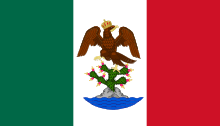
In 1910, as part of the celebrations marking the centennial of the Hidalgo revolt of 1810, President Porfirio Díaz inaugurated the monument to Mexico's political separation from Spain, the Angel of Independence on Avenida Reforma. The creation of this architectural monument is part of the long process of the construction of historical memory of Mexican independence.
Although Mexico gained its independence in September 1821, the marking of this historical event did not take hold immediately. The choice of date to celebrate was problematic, because Iturbide, who achieved independence from Spain, was rapidly created Emperor of Mexico. His short-lived reign from 1821–22 ended when he was forced by the military to abdicate. This was a rocky start for the new nation, which made celebrating independence on the anniversary of Iturbide's Army of the Three Guarantees marching into Mexico City in triumph a less than perfect day for those who had opposed him. Celebrations of independence during his reign were marked on September 27. Following his ouster, there were calls to commemorate Mexican independence along the lines that the United States celebrated in grand style its Independence Day on July 4. The creation of a committee of powerful men to mark independence celebrations, the Junta Patriótica, organized celebrations of both September 16, to commemorate Hidalgo's grito and the start of the independence insurgency, and September 27, to celebrate actual political independence.[61]
During the Díaz regime (1876–1911), the president's birthday coincided with the September 15/16 celebration of independence. The largest celebrations took place and continue to do so in the capital's main square, the zócalo, with the pealing of the Metropolitan Cathedral of Mexico City's bells. In the 1880s, government officials attempted to move the bell that Hidalgo rang in 1810 to gather parishioners in Dolores for what became his famous "grito". Initially the pueblo's officials said the bell no longer existed, but in 1896, the bell, known as the Bell of San José, was taken to the capital. It was renamed the "Bell of Independence" and ritually rung by Díaz. It is now an integral part of Independence Day festivities.[62]
There are plans for the commemoration of independence in 2021, as well as the establishment of the Mexican republic in 2024.[63] The 2021 event is termed the Consummation of Independence.[64]
See also
References
- Scheina. Latin America's Wars. p. 84.
- Archer, Christon I. "Wars of Independence" in Encyclopedia of Mexico. Chicago: Fitzroy Dearborn 1997, pp. 1595-1601.
- https://www.inside-mexico.com/mexican-independence-facts/ Archived 2019-01-12 at the Wayback Machine accessed Jan 11, 2019
- Mexico independiente, 1821-1851 Archived 2018-12-22 at the Wayback Machine, Monografias, 1996; accessed Dec 21, 2018.
- http://pares.mcu.es/Bicentenarios/portal/reconocimientoEspana.html Archived 2018-10-17 at the Wayback Machine accessed Dec 21, 2018.
- Brading, D. A. The First America: The Spanish Monarchy, Creole Patriots, and the Liberal State, 1492–1867. Cambridge: Cambridge University Press 1991.
- John Charles Chasteen. Born in Blood and Fire: A Concise History of Latin America. New York, Norton, 2001. ISBN 978-0-393-97613-7
- Altman, Ida, Sarah Cline, and Javier Pescador, The Early History of Greater Mexico. Prentice Hall 2003, pp. 246-247.
- Jonathan I. Israel. Race, Class, and Politics in Colonial Mexico, 1610-1670. Oxford: Oxford University Press 1975.
- Altman et al, The Early History of Greater Mexico, p. 247.
- quoted in Altman et al, The Early History of Greater Mexico, p. 248.
- Altman et al, The Early History of Greater Mexico, p. 249.
- Van Young, Eric The Other Rebellion: Popular Violence, Ideology, and the Mexican Struggle for Independence, 1810-1821. Stanford: Stanford University Press 2001.
- Brading, The First America
- John Tutino, From Insurrection to Revolution in Mexico: Social Bases of Agrarian Violence, 1750-1940. Princeton: Princeton University Press 1986.
- Hugh Hamill, The Hidalgo Revolt. Gainesville: University of Florida Press 1966, pp. 90-94.
- John Tutino, From Insurrection to Revolution, pp. 126-138.
- Tutino, From Insurrection to Revolution, pp. 138-183.
- Cañeque, Alejandro. The King's Living Image: The Culture and Politics of Viceregal Power in Colonial Mexico. New York: Routledge, 2004
- Guedea, Virginia. “Hidalgo Revolt” in Encyclopedia of Mexico. Chicago: Fitzroy Dearborn 1997, pp. 637-38.
- quoted in Krauze, Enrique. Mexico: Biography of Power. New York: HarperCollins 1997, p. 106.
- Guedea, Virginia. "Miguel Hidalgo y Costilla" in Encyclopedia of Mexico. Chicago: Fitzroy Dearborn 1997, p. 641.
- Guedea, Virginia, "Hidalgo Revolt" in Encyclopedia of Mexico. Chicago: Fitzroy Dearborn 1997, p. 638.
- Guedea, "Hidalgo Revolt", p. 638.
- Quoted in Isabel Fernández Tejedo and Carmen Nava Nava, “Images of Independence in the Nineteenth Century: The Grito de Dolores, History and Myth,” in !Viva Mexico! !Viva La Independencia!: Celebrations of September 16, edited by William Beezley and David E. Lorey. Wilmington: Scholarly Resources 2001, p.8.
- Guedea, "Hidalgo Revolt" p. 638.
- Peterson, Jeanette Favrot. "The Virgin of Guadalupe: Symbol of Conquest or Liberation?." Art Journal 51.4 (1992): 39-47.
- Krauze, Enrique. Mexico, Biography of Power. A History of Modern Mexico 1810–1996. HarperCollins: New York, 1997.
- Curcio-Nagy, Linda A. "Native Icon to City Protectress to Royal Patroness: Ritual, Political Symbolism and the Virgin of Remedies 1." The Americas 52.3 (1996): 367-391.
- Guedea, Virginia. "The Old Colonialism Ends, the New Colonialism Begins" in The Oxford History of Mexico. New York: Oxford University Press 2000, p. 289.
- Archer, Christon. "Military: Bourbon New Spain" in Encyclopedia of Mexico. Chicago: Fitzroy Dearborn 1997, 903.
- Guedea, "The Old Colonialism Ends", p. 289.
- Brewster, Claire (2005). "Women and the Spanish-American Wars of Independence: An Overview". Feminist Review. 79 (1): 20–35. doi:10.1057/palgrave.fr.9400200. JSTOR 3874426.
- Robert Harvey (2000). Liberators: Latin America's Struggle For Independence. Woodstock: The Overlook Press. Archived from the original on 2013-07-10.
- Krauze, Mexico: Biography of Power, p. 99.
- quoted in Krauze, Mexico: Biography of Power, p. 100.
- Krauze, Mexico: Biography of Power, p. 100.
- Young, Philip. History of Mexico: Her Civil Wars and Colonial and Revolutionary Annals. Gardners Books, [1847] 2007, pp. 84-86. ISBN 978-0-548-32604-6
- Ángel Miranda Basurto (2002). La Evolución de México [The Evolution of Mexico] (in Spanish) (6th ed.). Mexico City: Editorial Porrua. p. 358. ISBN 970-07-3678-4.
- Archer, "Military: Bourton New Spain", p. 904
- Archer, Christon. "Wars of Independence" in Encyclopedia of Mexico. Chicago: Fitzroy Dearborn 1997, p. 1597.
- quoted in Krauze, Mexico: Biography of Power, p. 107.
- http://www.lhistoria.com/mexico/sitio-de-cuautla Archived 2018-12-22 at the Wayback Machine accessed Dec 21, 2018.
- quoted in Krauze, Mexico: Biography of Power, p. 110.
- Archer, "Wars of Independence", pp. 1597-98.
- Morelos, José María. "Sentiments of the Nation, or Points Outlined by Morelos for the Constitution" in The Mexico Reader, ed. Gilbert M. Joseph et al. Durham: Duke University Press 2002, pp. 189-191.
- Guedea, "The Old Colonialism Ends", p. 291.
- Archer, "Wars of Independence" p. 1598.
- Archer, "Wars of Independence", p. 1599.
- Timothy J. Henderson (2009). The Mexican Wars for Independence. Macmillan. pp. 115–16. ISBN 9780809095094.
- Archer, "Wars of Independence" p. 1599.
- Archer, Christon I., "Royalist Scourge or Liberator of the Patria? Agustín de Iturbide and Mexico's War of Independence, 1810-1821," Mexican Studies / Estudios Mexicanos (2008) 24#2 pp 325-361
- Vincent, Theodore G. The Legacy of Vicente Guerrero, Mexico's First Black Indian President. Gainesville: University of Florida Press 2002, 123-127.
- Vincent, The Legacy of Vicente Guerrero, p. 130-31.
- Archer, "Wars of Independence", p. 1600.
- Guedea, "The Old Colonialism Ends", pp. 298-99.
- Philip Russell (2011). The History of Mexico: From Pre-Conquest to Present. Routledge. p. 132. ISBN 9781136968280. Archived from the original on 2016-06-10. Retrieved 2015-11-25.
- Christon I. Archer (2007). The Birth of Modern Mexico, 1780-1824. Rowman & Littlefield. p. 220. ISBN 9780742556027. Archived from the original on 2016-05-09. Retrieved 2015-11-25.
- Orozco Linares, Fernando (1996). Fechas históricas de México: las efemérides más destacadas desde la época prehispánica hasta nuestros días (in Spanish). Panorama Editorial. p. 128. ISBN 9789683802958. Retrieved 22 August 2018.
- "Tratado Definitivo de Paz entre Mexico y España" (PDF) (in Spanish). Archived (PDF) from the original on 2016-03-04. Retrieved 2018-04-30.
- Michael Costeloe, "The Junta Patriótica and the Celebration of Independence in Mexico City, 1825-1855" in !Viva Mexico! !Viva la Independencia! Celebrations of September 16, eds. William H. Beezley and David E. Lorey. Wilmington: SR Books 2001, pp. 44-45.
- Isabel Fernández Tejedo and Carmen Nava Nava, "Images of Independence in the Nineteenth Century: The 'Grito de Dolores', History and Myth" in !Viva Mexico! !Viva la Independencia! Celebrations of September 16, eds. William H. Beezley and David E. Lorey. Wilmington: SR Books 2001, pp. 33-34.
- Emiliano Hernández Camargo, "Bicentenario de la independencia y la república". El Sol de Durango 2019/04/25 Archived 2020-03-20 at the Wayback Machine accessed 20 March 2020
- "Historiadores se reunen con miras al bicentenario de la consumación de la independencia en 2021". INAH, Gobierno de México.2019/09/10 Archived 2020-03-20 at the Wayback Machine accessed 20 March 2020
Further reading
- Annino, Antonio. "The Two-Faced Janus: The Pueblos and the Origins of Mexican Liberalism" in Cycles of Conflict, Centuries of Change: Crisis, Reform, and Revolution in Mexico, Elisa Servín, Leticia Reina, and John Tutino, eds. Durham: Duke University Press 2007, pp. 60-90.
- Anna, Timothy E. (1978). The Fall of Royal Government in Mexico City. Lincoln: University of Nebraska Press. ISBN 0-8032-0957-6.
- Anna, Timonty E. "The Army of New Spain and the Wars of Independence, 1790-1821". Hispanic American Historical Review 61:4 (Nov. 1981).
- Archer, Christon I. "Insurrection--Reaction--Revolution--Fragmentation: Restructuring the Choreography of Meltdowwn in New Spain during the Independence Era." Mexican Studies/Estudios Mexicanos 10 , no 1. Winter 1994:63-98.
- Archer, Christon I., ed. The Birth of Modern Mexico. Wilmington DL: SR Publishers 2003.
- Beezley, William H. and David E. Lorey, eds. !Viva Mexico! !Viva la Independencia!: Celebrations of September 16. Wilmington DL: Scholarly Resources Books 2001.
- Benjamin, Thomas. (2000). Revolución: Mexico's Great Revolution as Memory, Myth, and History (University of Texas Press). ISBN 978-0-292-70880-8
- Benson, Nettie Lee. "Elections of 1809: Transforming Political Culture in New Spain." Mexican Studies/Estudios Mexicanos Feb. 2004, vol. 20(1): 1-20.
- Benson, Nettie Lee. "The Contested Mexican Election of 1812." The Hispanic American Historical Review 26.3 (1946): 336-350.
- Benson, Nettie Lee, ed. Mexico and the Spanish Cortes. Austin: University of Texas Press 1966.
- Dominguez, Jorge. Insurrection or Loyalty: the Breakdown of the Spanish American Empire. Cambridge: Harvard University Press 1980.
- Flores Caballero, Romero. La contrarevolución en la independencia: Los españoles en la vida política, social, y económica de México, 1804-1838. Mexico City: El Colegio de México 1984.
- García, Pedro. Con el cura Hidalgo en la guerra de independencia en México. Mexico City: Fondo de Cultura Económica 1982.
- Guedea, Virginia. "The First Popular Elections in Mexico City, 1812-1813" in the Evolution of the Mexican Political System. Jaime E. Rodríguez O., ed. Wilmington: Scholarly Resources 1993.
- Hamill, Jr. Hugh M. "Early Psychological Warfare in the Hidalgo Revolt," Hispanic American Historical Review (1961) 41#2 pp. 206–235 in JSTOR
- Hamill, Hugh M. (1966). The Hidalgo Revolt: Prelude to Mexican Independence. Gainesville: University of Florida Press.
- Hamnett, Brian R. (1986). Roots of Insurgency: Mexican Regions, 1750–1824. Cambridge University Press. ISBN 978-0521-3214-88.
- Hamnett, Brian R. "Royalist Counterinsurgency and the Continuity of Rebellion: Guanajuato and Michoacán, 1813-1820" Hispanic American Historical Review 62(1)February 1982, pp. 19–48.
- Hamnett, Brian R. Roots of Insurgency: Mexican Regions 1750-1824. Cambridge: Cambridge University Press 1986.
- Knight, Alan (2002). Mexico: The Colonial Era. Cambridge University Press. ISBN 9780521891967.
- Macías, Ana. Génesis del gobierno constitucional en México. Mexico City: Secretaría de Educación Pública 1973.
- Rodríguez O. Jaime E. The Independence of Spanish America. Cambridge: Cambridge University Press 1998. ISBN 978-0-521-62673-6
- Rodríguez O., Jaime E. "From Royal Subject to Republican Citizen: The Role of the Autonomists in the Independence of Mexico." In the Independence of Mexico and the Creation of the New Nation. Jaime Rodriguez O. ed. Los Angeles: UCLA Latin American Center 1989, pp. 19-44.
- Rodríguez O., Jaime E. "The Nature of Representation in New Spain." In Political Culture in Spanish America, 1500–1830, 31-50. Lincoln; London: University of Nebraska Press, 2017. Accessed June 29, 2020. www.jstor.org/stable/j.ctt1xhr7ns.7.
- Rodríguez O., Jaime E., ed. The Independence of Mexico and the Creation of the New Nation. Los Angeles: UCLA Latin American Center Publications 1989. ISBN 978-0-87903-070-4
- Timmons, Wilbert H. (1963). Morelos of Mexico: Priest, Soldier, Statesman of Mexico. El Paso: Texas Western College Press.
- Tutino, John. From Insurrection to Revolution in Mexico: Social Bases of Agrarian Violence, 1750-1940. Princeton: Princeton University Press 1986.
- Van Young, Eric. "Islands in the Storm: Quiet Cities and Violent Countrysides in the Mexican Independence Era." Past and Present 118 (Feb. 1988).
- Vincent, Theodore G. The Legacy of Vicente Guerrero, First Black Indian President of Mexico. Gainesville: University of Florida Press 2001.
- Warren, Richard A. Vagrants and citizens: Politics and the Masses in Mexico City from Colony to Republic. Rowman & Littlefield, 2007.
External links
- Chieftains of Mexican Independence
- Image of women participating in Mexican Independence Day celebrations, Los Angeles, 1935. Los Angeles Times Photographic Archive (Collection 1429). UCLA Library Special Collections, Charles E. Young Research Library, University of California, Los Angeles.